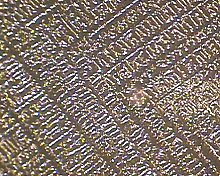BATT ™ Cast Alloy Laps.


So I began making them, and continuing to experiment with improving the alloy, the casting process, the machining, and the surface characteristics. Many people have since made them, and have had good results. However, even the 95/5 alloy required fairly thick, heavy castings in order to be dimensionally stable. This consumed a lot of expensive alloy, and cost a lot to ship. I no longer cast 95/5, as it is available commercially everywhere as a lead-free solder. I continue to encourage people to make their own, if they wish.
The new alloy, which has completed its field trials by dozens of experienced faceters was named "BATT". Its casting and machining properties are superior to 95/5, and more importantly, perform better with oxide polishes.
In the following metallograph, note the highly ordered grain structure in "BATT" as various alloying components crystallize when the alloy cools.

This is not a eutectic solution, but becomes more of a composite, with differing hardness domains, a finer grain structure, and results in a much stiffer alloy which does work harden, while retaining tin's low coefficient of friction and lack of toxicity. Another purpose of this alloy is also to provide better performance on water suspensions of common polishes, as well as with diamond compounds.
From left to right: 0.05 micron Aluminum Oxide, Titanium Dioxide, Cerium Oxide, and 5 micron Aluminum Oxide (#4,000).
I will make a 6" for US$ 55, or an 8" for US$ 70. Shipping by Priority Mail in the US is $4 for the 6", $5 for the 8". Shipping by USPS Air to Europe or Scandinavia isUS $16.70
Send Check or Money Order to:
PO Box 533
North Easton, MA 02356 USA.
Please e-mail me in advance so I will be able to respond more quickly. I have to make these evenings, but have so far been able to make them in a week or less after someone orders them.
